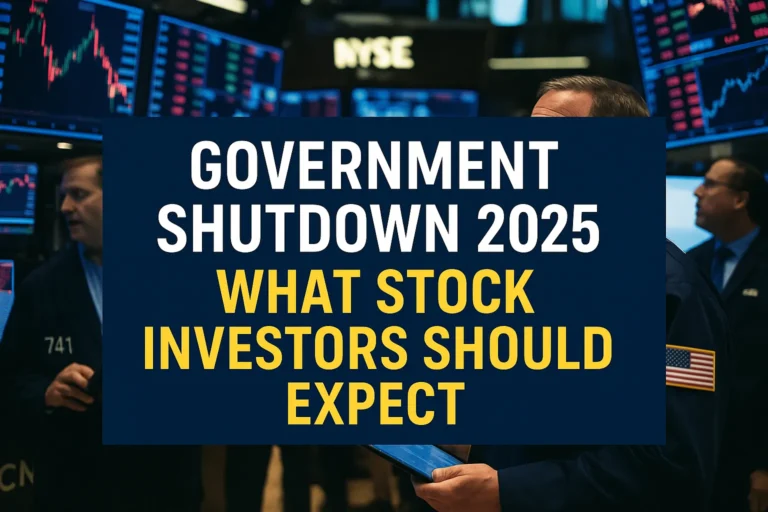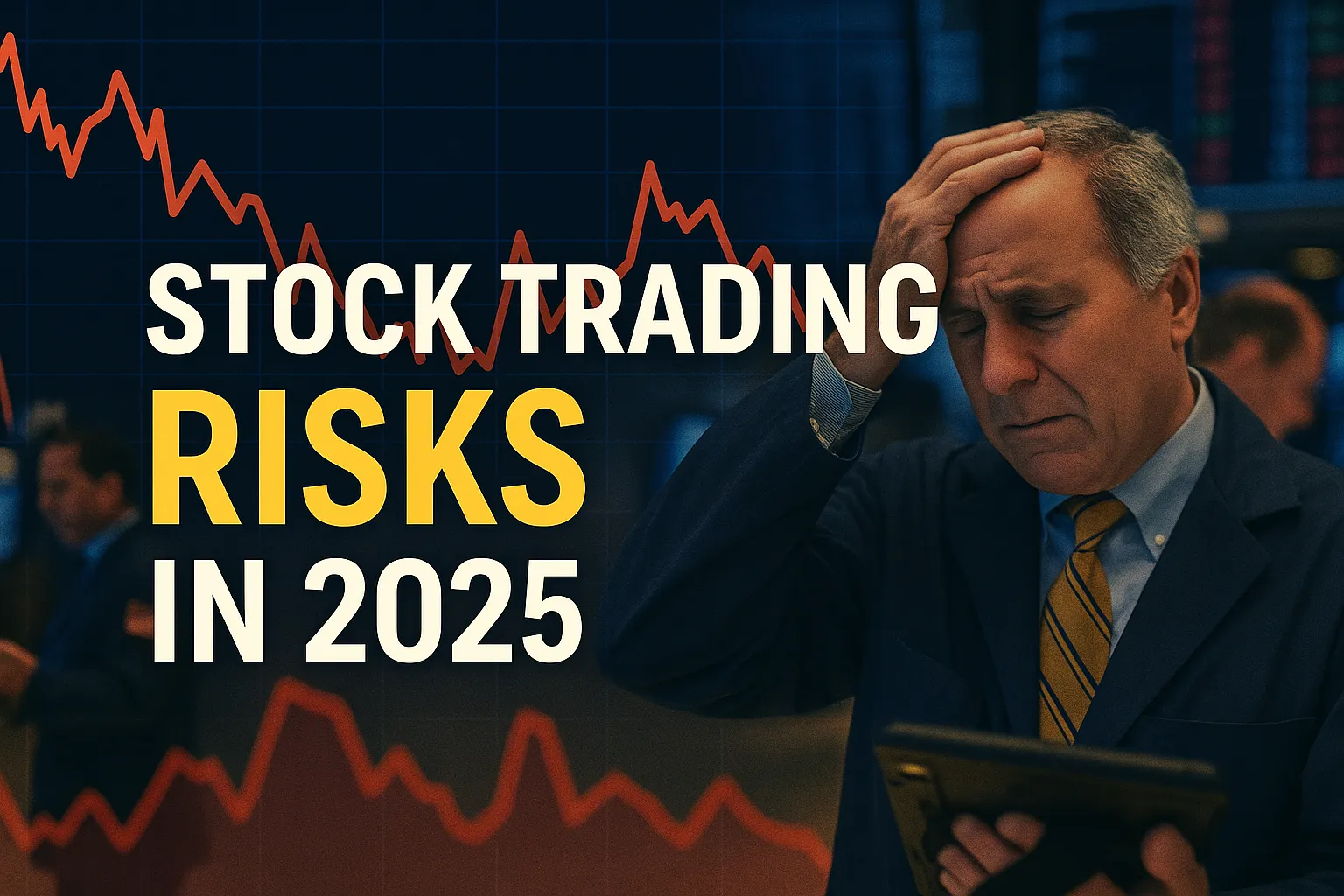
Government Shutdown 2025: What Stock Investors Should Expect
If a federal funding lapse occurs, government shutdown 2025 stock investors will want a clear playbook: which sectors tend to wobble first, how liquidity and volatility usually react, and what risk controls help protect capital during headline-driven swings. This guide outlines practical, data-informed steps you can take before, during, and after a shutdown window.
Key Points
- 🧭 Baseline impact: Short-term volatility often rises as discretionary spending stalls and policy timelines slip; watch bid–ask spreads and volume.
- 🏛️ Most exposed: Federal contractors, defense suppliers on delayed awards, small caps reliant on permits/approvals, and travel/tourism near federal sites.
- 📉 Macro data delays: Key economic releases can be postponed, increasing uncertainty and model error for traders and algos.
- 💵 Rates & liquidity: Treasury market functioning is typically resilient, but headline risk can shift curves; mind duration and cash buffers.
- ⚡ Energy & materials: Energy permitting and certain reporting flows can slow; metals can trade on risk-off or USD strength—plan position sizing accordingly.
- 🛡️ Risk controls: Pre-define max loss per trade, use staggered entries, widen stops only if volatility-adjusted, and avoid over-concentration.
- 📆 Scenario planning: Map 3 paths—brief shutdown (days), moderate (1–2 weeks), prolonged (2+ weeks)—with triggers for scaling in/out.
- 🔁 After re-opening: Expect catch-up in data & flows; re-assess theses as backlogs clear and guidance resumes.

How Major Outlets Frame Government Shutdown Stock Risks
When analyzing the government shutdown 2025 stock investors narrative, it’s useful to see how mainstream financial outlets frame the risks. Sites like Reuters, Bloomberg, and CNBC highlight volatility in equity futures, short-term Treasury yields, and sector-specific delays in approvals or contracts.
While these reviews often emphasize macroeconomic uncertainty, they don’t always provide tactical guidance for traders who must manage risk in real time. That’s where Silver Rally Trading Strategy Signals and actionable research from independent platforms can fill the gap—offering precise entry/exit triggers rather than broad commentary.
Compared to competitor coverage, our approach focuses on three things:
- ⚡ Real-time signals aligned with volatility spikes.
- 📊 Sector rotations that often appear in energy, defense, and utilities during shutdowns.
- 🛡️ Risk-adjusted sizing to keep capital drawdowns contained.
A Practical Playbook for Traders During a Shutdown Window
For government shutdown 2025 stock investors, the edge comes from pre-planned rules that adapt to headline-driven volatility. Focus on sizing, liquidity, and timing rather than trying to predict political outcomes. Use volatility-adjusted stops, limit orders in thin books, and staggered entries to avoid poor fills during surprise news drops.
Position Sizing & Risk Controls
- Cap daily loss and per-trade loss; stop trading for the day if either is hit.
- Use ATR- or volatility-based stops; widen only if you also reduce size.
- Favor liquid tickers and avoid crowded premarket gap chases.
- Scale in/out around key levels; avoid all-in entries on the open.
Data, Liquidity & Timing
- Expect delayed macro releases; adapt models to missing prints.
- Watch Treasury curve moves and funding headlines from the U.S. Treasury and CBO.
- Use a “first hour light” rule if spreads are wide; add only as liquidity normalizes.
- Keep a cash buffer for forced opportunities on outsized moves.
Which Playstyles Hold Up Best?
Short-term mean-reversion and catalyst-aware momentum can both work if risk is disciplined. If you’re weighing timeframes, see our breakdown in Day Trading vs Swing Trading to match exposure length with your risk tolerance during uncertain policy windows.
Want a quick refresher on shutdown mechanics and market context? See primers at Investopedia and live coverage via Yahoo Finance.
Get Real-Time Signals When Volatility Spikes
Receive entries, stops, and risk levels tuned for shutdown-era conditions.
Join TradeStockAlerts — Start Today No hype. Actionable signals. Cancel anytime.
Sector-by-Sector Impact for Investors
A prolonged shutdown doesn’t hit all industries equally. Historical patterns show that government contractors, airlines, and small-cap biotech are particularly vulnerable, while utilities, defensive consumer staples, and precious metals often outperform.
The government shutdown 2025 stock investors should also track how liquidity shifts across sectors. Delayed permits can slow energy exploration, while postponed FDA reviews disrupt biotech pipelines. Investors with diversified exposure to metals and EV-related plays can hedge policy-driven slowdowns, as outlined in our Critical Metals EV Boom Investing guide.
What Historical Data Tells Us
- 📊 Short-term volatility: Median VIX spikes 10–15% during the first week of past shutdowns.
- 📉 Federal contractor lag: Contractors underperform S&P 500 by ~4% over a 2-week window.
- 🪙 Metals resilience: Silver and gold often see safe-haven inflows while USD strengthens modestly.
Risk Matrix & Trade Setup Templates
During headline-heavy periods, government shutdown 2025 stock investors benefit from a repeatable framework that turns uncertainty into predefined actions. Use the matrix below to map volatility, liquidity, and catalyst risk to your sizing, entry style, and stop placement.
| Market State | Volatility (ATR / VIX) | Liquidity (Spreads/Depth) | Primary Risk | Position Sizing | Entry Method | Stop Logic |
|---|---|---|---|---|---|---|
| Calm drift | Low / falling | Normal | Trend fade | 0.25R–0.5R per leg | Pullback to VWAP/MA | ATR(14) × 1.0 beyond swing |
| Headline chop | Moderate / rising | Thinning at open | Whipsaw | 0.25R per leg (scale) | Staggered limits; avoid market | ATR × 1.3; reduce size 20–30% |
| Risk-off break | High / spiking | Wide spreads | Gap & slip | 0.1R–0.2R trial | Breakout with confirmation | ATR × 1.5 hard stop + time stop |
| Post-resolution | Normalizing | Improving | Reversion | 0.3R–0.5R | Retest of broken level | ATR × 1.0; trail after R=1 |
Position Construction Rules
- Cap exposure per theme: Max 30–40% of account across shutdown-sensitive names.
- Three-tier scaling: 40% → 35% → 25% of intended size as price confirms.
- Hard daily loss stop: −2R (stop trading for the session once hit).
- Overnight risk: Keep swing sizes half of day-trade sizes during active negotiations.
- Liquidity filter: 20-day median volume ≥ 1.5× your entry clip; avoid illiquid tails.
Example Playbooks by Sector
Defense & Contractors
Prefer post-dip stabilization over early knife catches; wait for contract/backlog commentary.
- Bias: Neutral → cautious long
- Trigger: Higher low above VWAP
- Invalidation: VWAP loss + volume surge
Utilities & Staples
Defensive bid can strengthen on uncertainty; fade overextensions using mean-reversion bands.
- Bias: Buy pullbacks
- Trigger: 20/50MA confluence hold
- Invalidation: Close below 50MA
Metals & Materials
Safe-haven flows possible; align with DXY and rates. See our metals guide for thesis structure.
- Bias: Long on risk-off with USD check
- Trigger: Breakout + volume confirmation
- Invalidation: DXY spike without metals follow-through
Execution Checklist (Print-Friendly)
- Pre-market: Mark key levels; set alerts; define R and max daily loss.
- Open: Trade “light” first 15–30 min if spreads are wide.
- Midday: Add only on confirmation; avoid boredom trades.
- Power hour: Tighten trails; prioritize realized gains over wishful holds.
- After close: Journal setups; tag what worked under shutdown conditions.
Keep fundamentals in view while trading the tape. For plain-English references, see Investopedia; for live market context use Yahoo Finance.

Positioning for Medium- to Long-Term Investors
Not all investors need to trade the headlines. For government shutdown 2025 stock investors, the biggest opportunity may be in patience. Markets often recover once political uncertainty fades, and disciplined investors who maintain diversification tend to outperform those who panic-sell.
Strategic Allocations to Consider
- 📈 Index funds & ETFs: Maintain exposure to SPX/QQQ while trimming overvalued small caps.
- 🪙 Silver & metals: Diversify with hedges that historically benefit from safe-haven demand (Silver Rally Trading Strategy Signals).
- ⚡ EV & critical materials: Longer-term themes are intact despite short-term delays (Critical Metals EV Boom Investing).
- 💵 Cash reserves: A 5–10% allocation allows opportunistic entries after volatility subsides.
Historical Perspective
Data from previous shutdowns shows that equity markets often retrace losses within months, provided the macro backdrop (rates, earnings growth) remains stable. The key takeaway: political gridlock is disruptive, but rarely a structural bear-market trigger.
For historical data, see Congressional Budget Office reports. For sector analysis and live updates, reference Reuters and CNBC.
FAQs: Government Shutdown 2025 & Stock Investors
Do government shutdowns always cause the stock market to drop?
Not always. Markets often react with short-term volatility, but direction depends on context (rates, earnings, duration of the shutdown). Many past episodes saw choppy trading followed by stabilization once funding resumed.
Which sectors are usually most affected?
Federal contractors, certain healthcare/biotech names awaiting approvals, and travel/tourism near federal sites can see pressure. Defensive groups (utilities, staples) and precious metals sometimes gain relative strength.
Will economic data releases be delayed?
Some data prints can be postponed when agencies pause non-essential functions. That increases uncertainty for models and algos; plan for wider ranges and consider reducing size until data flow normalizes.
How should traders adjust risk during a shutdown?
Use volatility-adjusted stops, stagger entries, limit orders in thin books, and a hard daily loss cap. Avoid over-concentration in shutdown-sensitive names and maintain a cash buffer for high-probability setups.
What’s a sensible approach for long-term investors?
Stay diversified, keep core index exposure, and rebalance rather than panic-sell. Consider selective hedges (e.g., metals) and hold cash for opportunities after volatility fades.
Where can I follow credible updates during the 2025 shutdown?
For official fiscal communication see the U.S. Treasury. For budget and analysis, review CBO publications, and for markets, consult live coverage at Yahoo Finance, Reuters, and CNBC.
Conclusion
For government shutdown 2025 stock investors, the key is preparation—not prediction. Define risk before you trade, size positions to volatility, and keep a flexible game plan for brief, moderate, and prolonged scenarios. When funding resumes and data flows normalize, revalidate your theses, trim weak exposures, and scale into higher-conviction setups.
Trade the Tape with Discipline—Get Our Real-Time Signals
Entries, exits, and risk levels tuned for shutdown-era volatility. No hype—just rules.
Join TradeStockAlerts
Pauline Lei
Pauline Lei is a financial markets writer at TradeStockAlerts.com. She specializes in stock trading strategies, metals investing, and forward-looking market analysis. Her work focuses on helping retail traders navigate volatility with disciplined, risk-first frameworks.